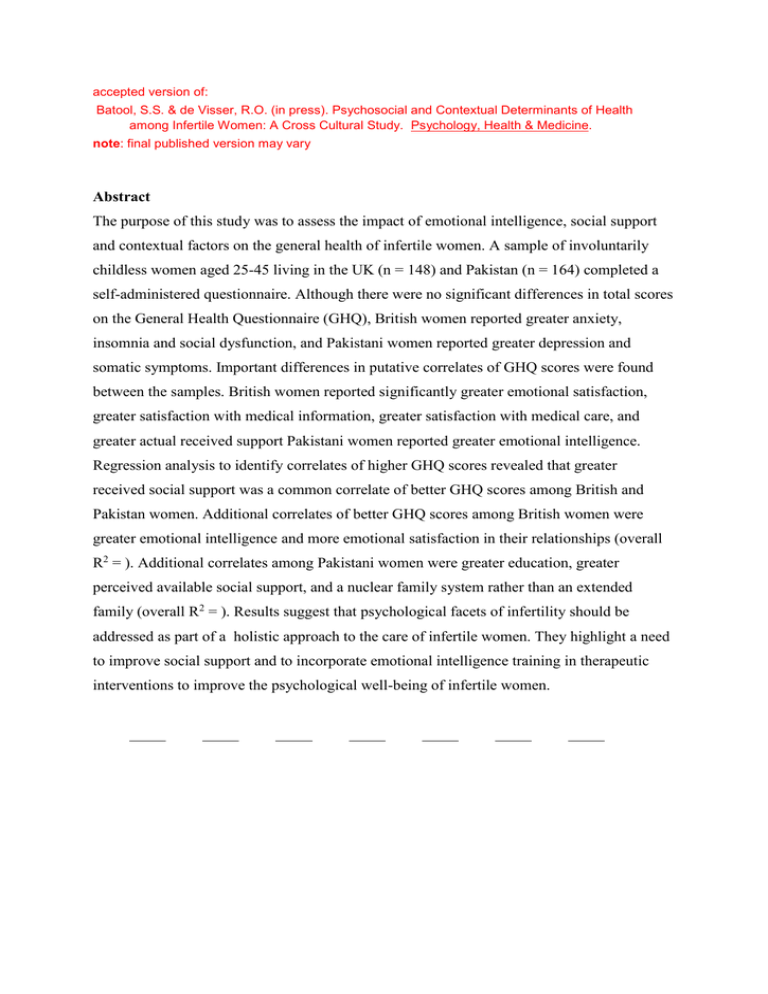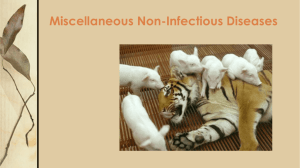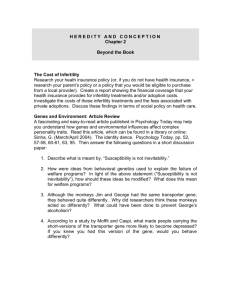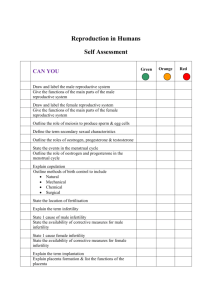Document
advertisement

accepted version of: Batool, S.S. & de Visser, R.O. (in press). Psychosocial and Contextual Determinants of Health among Infertile Women: A Cross Cultural Study. Psychology, Health & Medicine. note: final published version may vary Abstract The purpose of this study was to assess the impact of emotional intelligence, social support and contextual factors on the general health of infertile women. A sample of involuntarily childless women aged 25-45 living in the UK (n = 148) and Pakistan (n = 164) completed a self-administered questionnaire. Although there were no significant differences in total scores on the General Health Questionnaire (GHQ), British women reported greater anxiety, insomnia and social dysfunction, and Pakistani women reported greater depression and somatic symptoms. Important differences in putative correlates of GHQ scores were found between the samples. British women reported significantly greater emotional satisfaction, greater satisfaction with medical information, greater satisfaction with medical care, and greater actual received support Pakistani women reported greater emotional intelligence. Regression analysis to identify correlates of higher GHQ scores revealed that greater received social support was a common correlate of better GHQ scores among British and Pakistan women. Additional correlates of better GHQ scores among British women were greater emotional intelligence and more emotional satisfaction in their relationships (overall R2 = ). Additional correlates among Pakistani women were greater education, greater perceived available social support, and a nuclear family system rather than an extended family (overall R2 = ). Results suggest that psychological facets of infertility should be addressed as part of a holistic approach to the care of infertile women. They highlight a need to improve social support and to incorporate emotional intelligence training in therapeutic interventions to improve the psychological well-being of infertile women. In most societies a women’s child bearing ability is closely linked to her status as a woman (Bos & vasn Rooij, 2007), so the condition of infertility may produce feelings of being unfeminine, unattractive, and worthless (Burns & Convington, 1999), and may increase the risk of developing mental health problems and relationship difficulties (Greil et al., 2010; Hinton, Kurinczuk & Ziebland, 2010; Khodakarami, Hashemi, Seddigh, Hamdiyeh, 2010; Klemetti, Raitanen, Sihvo, Saarni & Koponen, 2010). Couples whose culture emphasises the centrality of the parental role experience more emotional difficulties if confronted with fertility problems (Newton et al., 1999). The adverse health effect of stressors such as infertility can be mediated by adaptive coping. Emotional intelligence (EI) is a reflection of competencies for handling stressful conditions, and is related to more adaptive stress responses ((Matthews, Zeidner & Roberts, 2004; Schutte et al, 1998). To date, no study has explored the importance of EI among infertile women, or its cross-cultural importance (Matthews et al., 2004). Social support is an important interpersonal resource that is associated with lower levels of depression and anxiety among infertile women (Mahajan, Turnbull, Davies, Jindal, Briggs & Taplin 2009; Martins, Peterson, Almeida & Costa, 2011; Slade, O’Neill, Simpson & Lashen, 2007). There is a lack of cross-cultural research into social support in infertility. It is also important to consider the influence of factors such as duration of infertility, and treatment experiences (Verhaak et al., 2001). The negative impact of infertility and its treatment may be associated with greater age, longer duration of infertility, lower education, and lower income (Drosdzol & Skrzypulec, 2008; Wang et al., 2007). This study addresses van Balen & Inhorn's (2002) call to investigate infertility in varied global settings. The aim was to fill a knowledge gap by examining the role of social support, EI, and contextual factors in infertile women's well-being. Involuntary childlessness in western countries tends to be much more accepted, and its emotional and social consequences are less severe when compared to developing countries (Batool & de Visser, 2013; van Balen & Bos, 2009). Pakistani society places great emphasis on women's fertility, whereas in the UK child bearing is more a matter of choice and women often delay motherhood in pursuing higher education and careers (McDonnell, 2012). Method Sample The sample consisted of involuntarily childless British and Pakistani women with a medical diagnosis of primary infertility, and who had been in a relationship and trying to get pregnant for at least two years. The British sample comprised 148 infertile women aged 2145 (mean = 35.6): 38 completed an online survey after receiving an email about the study; 110 completed a paper questionnaire after a direct approach at a fertility clinic in Brighton, UK. All women lived with their partner, and 131 were married. The Pakistani sample comprised 164 infertile women aged 20-42 (mean = 32.5) approached at hospitals in Lahore, Pakistan. All were married: 82 lived with in-laws and 82 lived separately with their husbands. Measures Age, education, relationship duration, living arrangements, and time since diagnosis were assessed via items constructed for this study. For other variables, permission was obtained from authors to translate scales from English to Urdu for use in Pakistan. Original scales were translated and back-translated by experts. The key outcome variable was subjective well-being as assessed by the General Health Questionnaire (GHQ-28: Goldberg, 1978), which consists of four domains: Somatic Symptoms; Anxiety and Insomnia; Social Dysfunction; and Severe Depression. Higher scores indicate poorer psychological well-being (UK α = .95, Pakistan α = .93). The Scale of Emotional Intelligence (Batool & Khalid, 2011) includes 56-items in 10 domains: interpersonal skill, self-regard, assertiveness, self-awareness, empathy, impulse control, flexibility, problem solving, stress tolerance, and optimism (e.g., “I see the positive aspect of circumstances”). Higher scores denote greater EI (UK α = .78, Pakistan α = .82). Two of the six subscales of the Berlin Social Support Scale (Schwarzer & Schulz, 2000) were used: the 8-item Perceived Available Support (PAS) scale (e.g., “I know some people upon whom I can always rely”; UK α = .93, Pakistan α = .83), and the 15-item Actual Received Support (ARS) scale (e.g., “This person comforted me when I was feeling bad”; UK α = .95; Pakistan α = .91). Higher scores indicated greater PAS and ARS. Two items assessed women's relationship satisfaction: “How [emotionally/physically] satisfying is your relationship with your partner?”; “How physically satisfying is your relationship with your partner?” (Richters, Grulich, de Visser, Smith & Rissel, 2003). Three items measured satisfaction with medical care. The stem “How satisfied are you with the ...”, was followed by: “amount of information you have received during treatment”; “emotional support you have received from your consultant?”; and “medical care you have received?”. Higher scores indicated greater satisfaction. Procedure Ethical approval was granted by the host institutions in Pakistan and the UK, and permission obtained from hospital clinics. Women attending infertility clinics who responded to a request to participate received a questionnaire which they could complete and return on the day or mail to the researchers. In the UK, additional women were recruited online via an Infertility UK forum. All participants gave informed consent. Data were collected January April 2012 in Pakistan and between October 2012 and February 2013 in the UK. Results Table 1 shows that British and Pakistani women were significantly different on several variables. British women had significantly greater: age; emotional satisfaction, satisfaction with medical information, satisfaction with medical care, and ARS. The differences in medical satisfaction indicated “large” effect sizes. There were no significant differences in overall GHQ scores, but British women reported greater anxiety/insomnia and greater social dysfunction, and Pakistani women reported greater depression and somatic symptoms. Pakistani women who lived with their partner in an extended family had poorer health than those who lived in separately as a couple (t (162) = 4.24, p <.01). Table 2 shows that in both samples, poorer health was associated with lower scores on: EI, PAS, and ARS, emotional satisfaction, satisfaction with medical information, satisfaction with emotional support. Among British women only, poorer health was associated with lower satisfaction with medical care. Among Pakistani women only, poorer health was associated with lower education and lower income. Regression analyses with forward selection of variable identified three significant multivariate correlates of poorer well-being among British women (Table 3): lower EI, less ARS, and less emotional satisfaction in dyadic relationship. Among Pakistani women, there were four significant correlates of lower GHQ scores: less ARS; lower education; lower PAS; and having an extended family system rather than a “nuclear” relationship (Table 3). Discussion The results accord with a view of infertility as a socially constructed experience (Greil, 1997). They extend current knowledge by challenging the idea that the emotional and social consequences of infertility are less for women in the West than in developing countries (van Balen & Bos, 2009). Actual received support from women's partners was the only common significant correlate of well-being for British and Pakistani women. In addition, PAS was a significant multivariate correlate of Pakistani women’s well-being. Previous work has indicated that social support may have direct and/or indirect effects on well-being in stressful circumstances, including infertility (Mahajan et al., 2009; Martins et al., 2011; Slade et al., 2007). In both samples, greater EI was a significant bivariate correlate of better GHQ scores, but only among British women was EI a significant multivariate correlate of well-being. EI may enhance capacity to overcome the negative effects of psychological distress related to infertility, and is an important predictor of well-being (Bhullar, Schutte & Malouff, 2012). Family structure was important among Pakistani women but not British women. Pakistani familes differs from “western” families in various extents, including stronger intergenerational ties and a greater prevalence of “extended” rather “nuclear” family systems: Pakistani women may therefore experience additional family pressures not present for British women (Batool & de Visser, under review; Sultan, 2009). The association between lower education and poorer well-being among Pakistani women reflects research in Western societies (Drosdzol & Skrzypulec, 2008; Moura-Ramos et al., 2012), and in Pakistan (Sultan & Tahir, 2011). Higher education may give Pakistani women wider social circles, and may allow women to revise life goals when parenthood is not achieved (Moura-Ramos et al., 2012; van Balen & Inhorn, 2002). Study findings should be interpreted in the light of certain limitations. The generalisability of the findings may be limited by the fact that the sample comprised only treatment-seeking infertile women who volunteered to participate. The cross-sectional design precludes statements about causal associations: prospective longitudinal research could better establish temporal ordering and strengthen such claims. Studies with larger samples may determine whether EI moderates or mediates links from other variables to GHQ scores. Intervention research could establish whether changes in putative predictors affect well-being. Infertile women's well-being appears to be influenced by individual, interpersonal, and cultural factors. Psychological aspects of infertility should be addressed as part of holistic approaches to the care: health professionals should consider how cultural factors and social support influence infertile women’s well-being. References Batool, S.S. & Khalid, R. (2011). Development of indigenous scale of emotional intelligence and evaluation of its psychometric properties. Pakistan Journal of Social and Clinical Psychology, 9, 66-72. Batool, S. S. & de Visser R.O. (2013). The psychosocial impact of infertility in Pakistan and the United Kingdom: A qualitative cross-cultural study. Article under review. Bhullar, N., Schutte, N.S. & Malouff, J. M. (2012). Associations of individualistic-collectivistic orientations with emotional intelligence, mental health and satisfaction with life: A tale of two countries. Individual Differences Research, 10, 165-175. Bos, H.M. W & Van Rooij, F. B. (2007). The influence of social and cultural factors on infertility and new reproductive technologies. Journal of Psychosomatic Obstetrics & Gynecology, 28, 65– 68. Burns, L.H. & Covington, S.N. (1999). Psychology of Infertility. In L.H. Burns & S.N. Covington, (Eds.), Infertility Counseling: A Comprehensive Handbook for Clinicians (pp. 3-25). Pearl River, NY: Parthenon. Drosdzol, A. & Skrzypulec, V. (2008). Quality of life and sexual functioning of Polish infertile couples. European Journal of Contraception and Reproductive Health Care . 13, 271-281. Goldberg, D. (1978). The General Health Questionnaire (GHQ-28). London: GL Assessment. Greil, A.L, Slauson-Blevins, K. & McQuillan, J. (2010). The experience of infertility: A review of recent literature. Sociology of Health and Illness, 32, 140–162. Greil, A.L.( 1997). Infertility and psychological distress: a critical review of the literature. Social Science & Medicine, 45, 1679–1704. Khodakarami, N., Hashemi, S., Seddigh, S., Hamdiyeh, M. & Taheripanah, R. (2010). Life Experience with Infertility; A phenomenological Study. Journal of Reproduction and Infertility, 10, 287-297. Klemetti, R., Raitanen, J., Sihvo, S., Saarni, S. & Koponen, P. (2010). Infertility, mental disorders and well-being - a nationwide survey. Acta Obstetricia et Gynecologica Scandinavica, 89, 677-682. Mahajan, N.N., Turnbull, D.A., Davies, M.J., Jindal, U.N., Briggs, N.E. & Taplin, J.E. (2009). Adjustment to infertility: the role of intrapersonal and interpersonal resources/vulnerabilities. Human Reproduction, 24, 906–912. Martins, M.V., Peterson, B.D., Almeida, V.M. & Costa, M.E. (2011). Direct and indirect effects of perceived social support on women’s infertility-related stress. Human Reproduction, 26, 2113– 2121. Matthews, G., Zeidner, M., Roberts, R.D. (2004).Emotional Intelligence: Science and Myth. USA: Massachusetts Institute of Technology (MIT) Press. McDonnell, E.J. (2012) Me, you and us: Intimate relationships and the question of children. Journal of Sociology, 48, 132-148. Moura-Ramos M., Gameiro, S., Canavarro, M.C., Soares, I, Santos, T.A. (2012).The indirect effect of contextual factors on the emotional distress of infertile couples. Psychology & Health, 27, 533-549. Richters J., Grulich, A.E., de Visser, R.O., Smith, A.M.A, & Rissel, C.E.(2003).Sex in Australia: sexual and emotional satisfaction in regular relationships and preferred frequency of sex among a representative sample of adults. Australian & New Zealand Journal of Public Health, 27, 171-179. Schutte, N.S., Malouff, J.M., Hall, L.E., Haggerty, D.J., Cooper, J.T., Golden, C.J. & Dornheim, L. (1998). Development and validation of a measure of emotional intelligence. Personality and individual Differences, 25, 167-177. Schwarzer, R. & Schulz, U. (2000). Berlin Social Support Scales. Retrieved online from http://userpage.fuberlin.de/~gesund/skalen/Language _Selection/Turkish/ Berlin_SocialSupportScales/berlin_social_support_scales.htm Slade, P., O’Neill, C., Simpson, A. J, Lashen, H. (2007).The relationship between perceived stigma, disclosure patterns, support and distress in new attendees at an infertility clinic. Human Reproduction, 22, 2309–2317. Sultan, S. & Tahir, A. (2011). Psychological consequences of infertility. Hellenic Journal of Psychology, 8, 229-224. Van Balen, F. & Bos, H. (2009). The social and cultural consequences of being childless in poor– resource areas. Journal of Obstetrics, Gynaecology & Reproductive Health, 1, 106–121. van Balen, F. & Inhorn, M.C. (2002). Interpreting infertility: A view from the social sciences. In M.C. Inhorn & F. van Balen (Eds.), Infertility around the globe: New thinking on childlessness, gender and reproductive technologies (pp. 3–32). Berkely: University of California Press. Verhaak, C.M., Smeenk, J.M., Eugster, A., Van Minnen, A., Kremer, J.A. & Kraaimaat, F.W (2001). Stress and marital satisfaction among women before and after their first cycle of in vitro fertilization and intracytoplasmic sperm injection. Fertility & Sterility, 76, 525–531. Wang, K., Li, J., Zhang, J.X., Zhang, L., Yu, J., Jiang, P.(2007).Psychological characteristics and marital quality of infertile women registered for in vitro fertilization-intracytoplasmic sperm injection in China. Fertility and Sterility, 87, 792–798. Table 1 Comparison between UK and Pakistani Samples UK (n=148) Pakistani (n=164) Mean (SD) Mean (SD) Differences Cohen’s d Age 35.61 (5.71) 32.51 (6.19) t (310)= 4.59, p < .01 0.52 Years since diagnosis 3.28 (4.49) 3.65 (3.25) t (282)= -.79, p = .43 0.09 Relationship duration 7.89 (5.02) 8.14 (4.39) t (310)= -.45, p = .65 0.05 Emotional satisfaction a 5.52 (1.54) 4.88 (1.09) t (310) = 4.24, p < .01 0.48 Physical satisfaction a 5.24 (1.68) 5.00 (.96) t (310)= 1.54, p = .12 0.17 4.98 (1.34) 3.52 (1.18) t (309)= 10.25, p < .01 1.60 3.84 (1.39) 4.05 (.79) t (308)= -1.67, p = .10 0.19 5.15 (1.15) 3.77 (.91) t (310)= 11.74, p < .01 1.32 Actual received support b 42.27 (12.63) 39.55 (9.82) t (309)= 2.13, p =.03 0.24 Perceived available support c 23.98 (7.52) 23.28 (4.63) t (310)= 1.00, p = .32 0.11 145.24 (13.34) 148.22 (13.07) t (310)= -1.99, p = .05 -0.23 31.95 (16.44) 32.99 (14.31) t (310)= -.09, p = .55 -0.07 Somatic Symptoms f 8.18 (4.68) 9.57 (4.10) t (310)= -.2.78, p < .01 -0.31 Anxiety & Insomnia f 9.77 (5.62) 8.45 (4.08) t (310)= 2.39, p = .02 0.30 9.12 (3.32) 8.24 (3.31) t (310)= 2.34, p = .02 0.26 4.87 (5.45) 6.72 (5.32) t (310)= -3.04, p < .01 -0.34 Satisfaction: medical information a Satisfaction: emotional support Satisfaction: medical care a d Emotional intelligence GHQ Total e Social Dysfunction f Severe Depression f a notes: a - range 1-7; b - range 15-60; c - range 8-32; d - range 56-224; e - range 28-112; f - range 7-28 8 Table 2 Correlations between Study Variables for UK Sample (n= 148; above diagonal) and Pakistani Sample (n= 164; below diagonal) Variables 1 2 1. Age - r =.33 p < .01 - 3 4 5 r =.20 r =.43 r =.34 p =.01 p < .01 p < .01 2. Education r =.34 r =.20 r =.04 r =.03 p < .01 p =.01 p =.66 p =.74 3. Annual Income r = .42 r = .76 r =.-.04 r = .07 p < .01 p < .01 p =.65 p =.39 4. Years since diagnosed r = .70 r = .23 r = .33 r = .56 p < .01 p <.01 p < .01 p < .01 5. Relationship Duration r = .71 r = .05 r = .18 r = .82 p < .01 p = .52 p = .02 p < .01 6. Emotional Satisfaction r = -.45 r = -.01 r = -.08 r = -.31 r = -.47 p < .01 p = .89 p = .31 p < .01 p < .01 7. Physical Satisfaction r = -.30 r = -.00 r = -.14 r = -.28 r = -.44 p < .01 p = .96 p = .07 p < .01 p < .01 8. Satisfaction: Medical r = .04 r = .46 r = .39 r = .05 r = -.10 Information p = .64 p < .01 p < .01 p = .55 p = .19 9. Satisfaction: Emotional r = -.07 r = .21 r = .16 r = -.10 r = -.13 Support p = .39 p <.01 p = .04 p = .22 p = .09 10. Satisfaction: Medical r = .02 r = .22 r = .27 r = -.02 r = -.06 Care p = .80 p <.01 p <.01 p = .85 p = .47 11. Emotional Intelligence r = .18 r = .25 r = .26 r = .06 r = .06 p = .02 p < .01 p < .01 p = .44 p = .46 12. PAS r = .18 r = .31 r = .35 r = .16 r = .08 p = .02 p < .01 p < .01 p = .06 p = .29 13. ARS r = .09 r = .26 r = .28 r = .08 r = .02 p = .21 p < .01 p < .01 p = .32 p = .85 14. General Health r = -.07 r = -.41 r = -.39 r = .02 r = .05 p = .36 p < .01 p < .01 p = .79 p = .54 PAS = Perceived Available Support; ARS = Actual Received Support 6 r =-.19 p =.02 r =.11 p =.18 r = .18 p = .03 r = -.17 p = .04 r = -.03 p = .70 - 7 r =-.37 p < .01 r =-.01 p =.89 r = .07 p = .42 r = -.15 p = .09 r = -.15 p = .06 r = .80 p < .01 r = .62 p < .01 r = .21 r = .13 p <.01 p = .09 r = .17 r = .06 p = .03 p = .47 r = .21 r = .23 p <.01 p <.01 r = .21 r = .02 p <.01 p = .75 r = .13 r = -.02 p = .10 p = .75 r = .27 r = .07 p < .01 p = .40 r = -.25 r = .01 p < .01 p = .90 9 8 r =-.13 p =.11 r =-.02 p =.79 r = -.03 p = .69 r = -.38 p < .01 r = -.18 p = .03 r = .30 p < .01 r = .19 p = .02 - 9 r =-.18 p =.03 r =-.02 p =.79 r = .02 p = .85 r = -.30 p < .01 r = -.15 p = .06 r = .35 p < .01 r = .35 p < .01 r = .52 p < .01 r = .28 p < .01 r = .31 r = .27 p < .01 p < .01 r = .33 r = .38 p < .01 p < .01 r = .30 r = .17 p < .01 p = .03 r = .45 r = .22 p < .01 p < .01 r = -.39 r = -.25 p < .01 p < .01 10 11 r =-.21 p =.01 r =-.06 p =.50 r = .00 p = .99 r = -.32 p < .01 r = -.25 p <.01 r = .16 p = .05 r = .15 p = .06 r = .70 p < .01 r = .52 p < .01 - r =-.06 p =.48 r =.26 p <.01 r = .14 p = .09 r = .04 p = .68 r = .09 p = .29 r = .45 p < .01 r = .47 p < .01 r = .18 p = .03 r = .31 p < .01 r = .17 p = .04 - r = .22 p <.01 r = .05 p = .49 r = .11 p = .15 r = .13 p = .11 12 r =-.19 p =.02 r =.03 p =.68 r = .00 p = .97 r = -.26 p <.01 r = -.22 p <.01 r = .27 p <.01 r = .42 p < .01 r = .28 p <.01 r = .16 p = .05 r = .31 p < .01 r = .19 p = .02 r = .44 p < .01 r = .46 r = .56 p < .01 p < .01 r = -.40 r = -.49 p < .01 p < .01 13 r =-.16 p =.06 r =.054 p =.51 r = .06 p = .48 r = -.28 p < .01 r = -.21 p <.01 r = .27 p <.01 r = .39 p < .01 r = .37 p < .01 r = .08 p = .31 r = .38 p < .01 r = .22 p <.01 r = .74 p < .01 - 14 r =.06 p =.45 r =-.14 p =.12 r = .01 p = .89 r = -.05 p = .58 r = -.12 p = .13 r = -.44 p < .01 r = -.43 p < .01 r = -.25 p <.01 r = -.21 p = .01 r = -.19 p = .02 r = -.61 p < .01 r = -.33 p < .01 r = -.40 p < .01 r = -.51 p < .01 Table 3 Significant Multivariate Correlates of General Health of Infertile Women b β t α Emotional Intelligence .52 .56 8.01 p < .01 Actual Received Support -.37 -.28 -4.17 p < .01 Emotional Satisfaction -1.88 -.17 -2.32 p =.02 British women (n = 148) F(3,141) = 32.36, p< .01; R2 = .41, Pakistani women (n = 164) Actual received support -.75 -.52 -7.62 p < .01 Education -2.85 -.29 -4.48 p < .01 Perceived available support -.72 -.23 -3.03 p < .01 Extended family system -4.62 -.16 -2.46 p = .01 F(4, 159) = 26.95, p< .01; R2 = .40, 10





